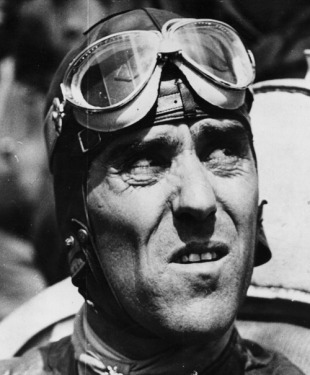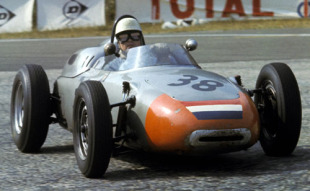
Tazio Nuvolari
Nuvolari was probably the greatest pre-Formula One driver, and was also accurately described by a close rival as "the boldest most skilful madman of all". He did well to make it to adulthood after jumping (unsuccessfully) off the roof of his family house in a home-made parachute. As a teenager he bought an airplane and immediately flew straight into a haystack. In World War One he was barred from driving ambulances for the Italian army, being deemed "too dangerous". Injuries on the track never deterred him. After a major accident in 1934 he discharged himself from hospital and raced with his foot in plaster. Two years later he crashed practising for the Tripoli Grand Prix and was placed in a plaster corset and told to rest. He smiled, and headed back to the circuit where he took part in the grand prix despite having almost no movement. In 1940 a collision left the bonnet of his Ferrari bent upwards, blocking his vision. Unable to shift it, he deliberately slammed the car into the side of a bridge to rip it off.
Sir Henry Segrave
Segrave, one of the best-known British inter-war drivers, was obsessed with speed and as well as racing captured a number of land and sea records. He also had an unconventional attitude to road junctions, crossing them flat out regardless of traffic or signals. "If you cross at 60mph the time you are 'zone of danger' is a third of that if you cross at 20mph and consequently the risk of meeting traffic is three times as great," he explained, not altogether convincingly. He on occasions got bored racing, and during one six-hour endurance event at Brooklands drove off the track and straight down to Southampton to go boating. Speed ultimately proved his downfall and he was killed going for another record on Lake Windermere in 1930.
Patrick Depailler
For Depailler, Formula One was not nearly dangerous enough to satisfy him. Shortly after being asked to take part in the last two races of the 1973 season by Tyrrell, he fell off a motorbike and broke his leg, resulting in his contract being amended prohibiting him from riding bikes. He became a familiar sight in the pit lane riding a bicycle while sitting on the handlebars, so few, other than it seems his then employers, Ligier, were surprised when he was seriously injured hang gliding in 1979. The team replaced him immediately. He was killed while practising for the 1980 German Grand Prix.
Bernd Rosemeyer
Rosemeyer was a brilliant pre-war driver for the legendary Auto Union team, winning the European Championship in 1936. As a fatalist, he tackled everything with a carefree attitude which often led to disagreements with the team's management. In 1936 they were horrified when he secured a place in Germany's bobsleigh team for the Olympics, and the following year he drove a practice session for a major race dressed in little more than a helmet, gloves, shorts and sandals … he smashed the lap record by more than 10 seconds. He was killed attempting the land-speed record in 1938, weeks before his 30th birthday.
Sir Henry Birkin
Birkin was one of the famous Bentley Boys whose early promise was snuffed out when his new wife banned him from racing, but eventually he decided it was more important to him than marriage and he returned to action in 1927 - in his 'retirement' he had kept his hand in by racing from Piccadilly to a pub in Norfolk; if he beat his set time he ate a hearty breakfast, if he didn't he immediately returned to London hungry. Undeterred by the death of his brother at the Isle of Man TT races, Birkin took any drive he could, and came third at the 1933 Tripoli Grand Prix despite having no mechanics. Sadly, it was his last race. Reaching out for a cigarette, he burned his arm on the car's exhaust pipe. The wound became infected and he died of blood poisoning three weeks later.

De Beaufort was a Dutch nobleman and one of the last genuine amateurs, funding his own cars which he ran in bright Dutch orange under the Ecurie Maarsbergen banner, the team taking its name from de Beaufort's country estate. Although early on he was seen as something of a joke - his solid frame led to his car being tagged "Fatty Porsche" - who got in the way, as time went on respect for him grew and in 1962 he twice finished sixth to earn two points. He was anything but conventional either, often driving without shoes and even donned a Beatles-style wig rather than a helmet. Once at Reims he stopped during a practice session to give an attractive young lady a ride round the circuit, to the fury of officials. He died when his Porsche 718 crashed at the Nürburgring, during practice for the 1964 German Grand Prix.
Gwenda Hawkes
Hawkes made her name setting speed records in the 1920s, a time when many thought the idea of women driving, let alone racing, was a sign of escalating moral degeneration. It was no easy path into racing either, as she honed her skills driving an ambulance in the war and carrying out repairs under fire. That military background was evident to her pit crew who she insisted had spotless white overalls at all times, and was not beyond sacking any of them found with so much as a splat of grease on them.
Alan Stacey
Stacey was one of two drivers killed at the 1960 Belgian Grand Prix, but what is amazing is that he was racing at all, given that he only had one leg - the lower part of his right one was amputated after a motorbike accident when he was 17. He drove for Lotus in an adapted car with a hand throttle, and one year at the French Grand Prix devised a scam to pass the stringent medical. "There is that test where the doctor touches your knee with a rubber hammer, to check the reflex," wrote journalist Gerard Crombac. "So Alan showed his proper leg for the first test, then I distracted the doctor's attention and Alan quickly made sure that he tested the same leg again!" To add to the rather bizarre situation, Stacey's main mechanic, Bill Bossom, only had one arm. Crombac recalled seeing the carefree Stacey "driving down the King's Road in a Jaguar K140, standing on the seat and only bending down to steer". His disability had nothing to do with his death - it is believed he was stuck in the face by a bird.
Andre Dubonnet
Dubonnet was one of the more colourful characters of an era that was not short of them. That he came from the famous French aperitif family allowed him to enjoy a hedonistic life of fun, racing cars, taking part in the 1924 Olympics in the bobsleigh, as well as marrying four times. To his credit, he distinguished himself in World War One when he was one of his country's leading fighter pilots. In the 1920s he poured money into cars, racing for Hispano-Suiza and Bugatti, but was not always the ideal team-mate. At the 1926 British Grand Prix, Robert Benoist handed over to Dubonnet in the lead. But Dubonnet, wearing a lounge suit and beret, had never driven the Brooklands circuit and eventually finished third. He also underwrote many inventions, including a suspension system he sold to General Motors. The family firm was sold in the 1960s, and Dubonnet turned his energies to solar power. But the good life did not come cheap and he died almost penniless.
Gilles Villeneuve
Villeneuve is regarded by many as the greatest driver never to win the championship, and he certainly left his mark on the sport in a short career which ended with his death at the Belgian Grand Prix in 1982. Professor Sid Watkins believed he was living on borrowed time, so many risks did he take. "He believed [when driving] in the 'gap theory' - there was always a place you could move when faced with a high-speed collision," Watkins recalled of one time he got a lift to the track with Villeneuve. "He ignored red lights, bounced off parked cars, never pausing or hesitating. I turned to speak to his wife but she was not visible … she had taken to the floor. She indicated this was normal for her." Villeneuve frequently took off in his helicopter with the fuel gauge on empty, and then flew in and out of power cables and pylons. "He's not like us," Jacques Lafitte said. "He's on a separate level. He has no fear."
Martin Williamson is managing editor of digital media ESPN EMEA
© ESPN Sports Media Ltd.
 Martin Williamson is managing editor of digital media ESPN EMEA Martin Williamson, who grew up in the era of James Hunt, Niki Lauda and sideburns, became managing editor of ESPN EMEA Digital Group in 2007 after spells with Sky Sports, Sportal and Cricinfo
Martin Williamson is managing editor of digital media ESPN EMEA Martin Williamson, who grew up in the era of James Hunt, Niki Lauda and sideburns, became managing editor of ESPN EMEA Digital Group in 2007 after spells with Sky Sports, Sportal and Cricinfo

